administrative things first
get used to the class site
All the pages share a similar look and functionality. On the top of each page is a navigation bar that has five sections (from left to right):
- a home & schedule link back to the class home page (which includes the schedule) and a drop-down menu that links to the syllabus, to how performance will be evaluated, and to the grading scheme
- a resources link to a collection of links on deli.cio.us that pertain to public library topics and a drop-down menu with links to other resources that might be useful
- a blog link to a list of public library blog addresses and a drop-down menu with links to other librarian-related blogs that may be of interest
- a drop-down menu with links to the four deliverables that will make up the evaluation for this class
- a drop-down menu with links you can use for connections to the class blog, to my page, and to my email address
All pages associated with a particular week will have at least two sub-components - a page discussing the topic of the week and a page of readings to prepare you for the topic of the following week. At the top of each weekly page is a task bar that will include (at a minimum):
- a link to the previous topic page
- a link to the readings for the topic of the week
- a link to the lecture notes for the topic of the week
- a link to the readings for the next topic week's topic
You will note that this initial page has no link to a previous topic and the last topic page will have no link to a readings for a subsequent topic.
Stylistically, you will note that when a direct quote is made, it will be set off. For example, here is Mark Hudson's review of our textbook.
The scholarly and practical literature on public libraries and librarianship is extensive, but for many years now there has been no adequate single-volume introduction to the field. Kathleen de la Peña McCook's Introduction to Public Librarianship not only provides a readable introductory textbook for library students and experienced practitioners alike, but does so in a way that challenges us to think beyond narrow institutional concerns and objectives and ground librarianship in our commitment to cultural democracy and social justice.
[top]
look at those components
- the syllabus
is pretty straightforward; we will be focused on public
libraries - where they have been & what they can be
- you will note that there is a textbook. It isn't cheap, but it will serve as both a good guide for the topic and a good source of reference material for future professional use
- the evaluation page lays out what we will be doing and when we will be doing them
- the grading page explains what the letter grades mean
[top]
we will have a page for each week's topic
We will be considering a topic each week. The plan will be to do the readings and then to post your thoughts about the readings on the blog and also engage in discussion with each other on the topics by commenting on each other's postings as appropriate.
Perhaps a diagram will be helpful.

[top]
we will have two papers to do this semester
- the first
will be a personalized, not-too-scholarly, but thoughtful
discussion of your feeling for public libraries
- you will want to describe your present public library in terms that have meaning to you - where is it, how does it fit into the community, what are its good and/or not so good points
- you will also want to describe the public library of your memory - the one that most helped form you as an individual
- the second will be a scholarly assessment of what you think a public library can be - you will want to use the readings (or any other resources) to support your thoughts on what your public library (either the one you know or the one you would want to know) should aim to do in the 21st century
[top]